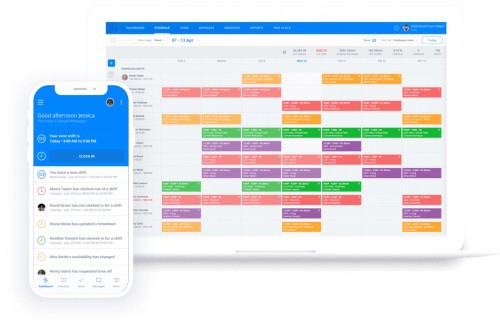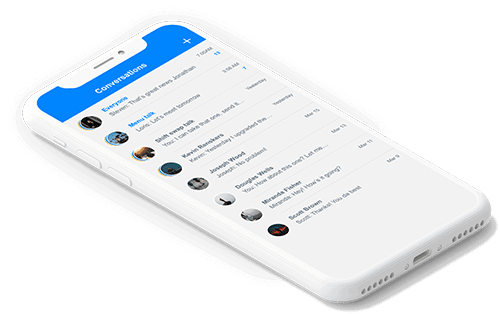20 Types of Work Schedules Every Manager Needs To Know
Work schedule types vary from business to business. To help you understand what ...

For most managers, timesheet reminders are a necessary evil. They ensure that all team members submit their time cards on time so they have everything they need to conduct payroll. But are timesheet reminders necessary?
In this article, we discuss some of the best timesheet reminders for your business and introduce you to a solution that can streamline the way you operate.

Timesheet reminders are important for motivating your team to turn in the records of their work hours. This information is vital for performing the calculations that keep your business successful.
The most important calculation you’ll have to conduct with your timesheet reminders is payroll. Even if you disregard the other two on this list, you’re legally obligated to run an accurate and efficient payroll.
That makes payroll the number one reason timesheet reminders are crucial. You’re legally obligated to run an accurate payroll, and without it, your business will suffer hefty fines and even substantial legal trouble.
Timesheets help you plan for the future. An analysis of time on task and total time worked helps you answer such questions as:
With that information in hand, you can implement processes that improve efficiency, productivity, and spending, both now and in any new projects for your team.
The data you get from team time cards can help you answer all kinds of project and management questions that relate to maximizing profit, including:
While profit does depend on a wide variety of factors, when you can control labor spending and adhere to your budget, you’ll be in a better position to manage the other variables involved.
Use short-term memory to your advantage! Remind your employees to fill out their timesheets right before they’re due.
If you address the mistake promptly, your employee can rectify it immediately. Embarrassment won’t have time to settle in, which can sometimes create more of a delay.
Try making it a weekly reminder. Monday mornings are often used for assessing the to-do list for the week. Add a timesheet reminder to the housekeeping tasks already in place.

Email was an early method for sending timesheet reminders quickly to a large team. And it’s still effective! Try including a call-to-action button or hyperlink in the email to make the task user-friendly.
Text messages are a great way to send reminders. Most people check their phone or tablet at least once a day.

The single most practical and productive way to reach everyone on your team is through your business’s time-tracking software. You can set it to display a message any time an employee uses the system (e.g., clocking in and recording time on task).
If your business uses a team communication app, like Sling, you can distribute timesheet reminders by direct message (DM).
In some cases, you can even set the software to send out reminders automatically. You can choose specific dates and times so everyone is sure to see the information.
Notifications (or push notifications) pop up on the main screen of a digital device, even if the device is locked and is often accompanied by a sound. Notifications stay there until the user reads them.

Remember this old-school method? You can use it to remind your team about timesheets! Whether you leave a voicemail on their company landline or their personal cell, it does the job of getting the word out.
Why has the poster timesheet reminder been around for some time? Because it works.
Get creative! Take some inspiration from these tip jar ideas and be sure to display copies in places that get a lot of traffic (like at the coffee machine or in the break room).
Timesheet reminders started out as just a few lines of text, but eventually, payroll managers got creative and included images with those words. This kicked off the meme trend that seems to be everywhere these days. A picture is worth a thousand words, after all.
If your business has a public address system, you might consider making an announcement for everyone to hear.
If you’ve got the time and wherewithal to do it, write out a memo and post it somewhere obvious on each employee’s desk.

Talking directly with your employees is personal. It allows you to make a real connection. But depending on the size of your team, it might be tough for you to reach everyone. Try pairing a face-to-face reminder with another method on this list.
Another idea? Try reminding everyone during team meetings. You’ll get more bang for your buck, plus you’ll know everyone receives the information at the same time and can remind each other.
What about rewarding your employees with an incentive if they all turn in their timesheets before the deadline? This can be a great motivator and bring lots of enjoyment to your team.
Consider such incentives as:
As you think about the incentives, take your employees’ motivations into account. This will help you find the just right reward for everyone on your team.

Company-wide calendar reminders may be just the thing your team needs to prod them into action.
Set an appointment during your team’s least busy time. Maybe that’s the first thing in the morning before work gets started. Or maybe at the end of the day when things are winding down.
Encourage your employees to use the “appointment” time to compile their work hours for the week or month, and then turn in their report. Set a reminder for five or 10 minutes before it’s set to start.

One of the easiest ways to ensure that you receive all the timesheets when you need them is by using time-tracking software to fill out the timesheets for your team.
With an app that combines scheduling, time tracking, and task management, your employees may be able to track their work time as they go. Then, the app can automatically create and submit their timesheets.
Automatic timesheet acquisition is by no means foolproof, though. An employee may still forget to track their time on a specific task, leading to gaps in the timesheet that make it incomplete for the payroll.
You may still need to send out timesheet reminders to get certain employees to fill in the blanks.
Still, the number of delinquent timesheets may be significantly lower than before, making it easier to track down the missing information you need to complete the payroll process.
Turn timesheets into a game! Here are some ideas for transforming your team’s timecard submission process into fun, friendly competitions that everyone will enjoy.
Assign one employee the role of timesheet hero. Task them with being responsible for everyone completing their time card before the due date.
Whether they’re successful or not, designate a specific reward, such as a free drink, a gift card, or lunch out for their efforts.
Organize a pizza party for your entire team at the end of the pay period. For every day an employee forgets to turn in their timesheet, they receive one dash of hot sauce on their slice!
As the due date approaches, compile and display a timesheet leaderboard. But, instead of tracking just one variable every time, switch it up without telling your team.
You might choose to track the fastest team member to submit their timesheet first and then the person with the least timesheet reminders. Get creative with your leaderboard!
Another great way to motivate your employees is to connect timesheet submission to one big bonus.
You may choose to hold a competition for three months, six months, or a full year. Maybe award points for the order in which you receive the timecards. There are so many ways to format this type of competition. You could even let your winner design the next one!
Regardless of which timesheet reminders you choose, try to keep these four guidelines in mind.

Though timesheet reminders may be necessary on some occasions, try not to make them a regular part of your workweek. Tracking down delinquent time cards can take up valuable time that you could dedicate to other, more important, tasks.
If you want to eliminate timesheet reminders altogether and streamline the payroll process, Sling is the answer.
The Sling suite of tools comes with a built-in time clock, automated reminders, exportable payroll reports, and much more. These features give you access to your team’s work hours when you need them and provide complete control over the employee payroll process.
For more free resources to help you manage your business, organize and schedule your team, and track and calculate labor costs, visit GetSling.com today.
See Here For Last Updated Dates: Link
This content is for informational purposes and is not intended as legal, tax, HR, or any other professional advice. Please contact an attorney or other professional for specific advice.
They really can be! Humor lightens up a message that might otherwise come across as dry. Just make sure you know the kind of humor that matches the culture of your company. You don’t want to surprise or offend anyone.
Timesheet images can be effective for a number of reasons. They create a sense of informality, which can put employees at ease. They’re also efficient.
Finally, images and words are not processed in the same way. So adding images to a timesheet ignites a different part of the brain.
While employees are not required to sign or approve their timesheets, you might find it makes sense for them to do it anyway. You may be able to avoid errors that might otherwise cause delays.
Employers who don’t prioritize precise time-keeping may use the rounding rules provided by the Fair Labor Standard Act. This federal law offers standards for calculating employee hours.
The seven-minute rule allows employers to round work time to the nearest quarter-hour. So if an employee works, let’s say, seven hours and six minutes, the employer can round down to seven hours. But if the employee works seven hours and eight minutes, the employer would round up.
Schedule faster, communicate better, get things done.